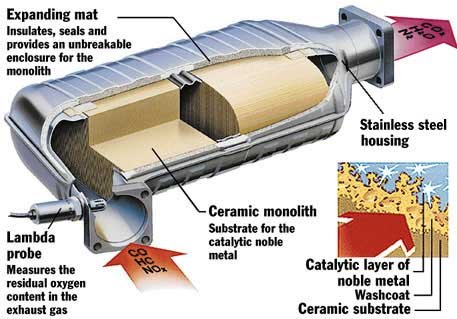Replacing a worn-out catalytic converter is a common but intricate task in automotive maintenance. While the procedure’s complexity varies depending on the vehicle, having a general understanding of the process and the challenges involved can provide peace of mind. In this article, we delve into the intricacies of catalytic converter replacement, exploring its difficulties, the required tools, and the potential costs associated..

Image: oards.com
Understanding the Catalytic Converter
A catalytic converter is a vital component of a vehicle’s exhaust system, responsible for reducing harmful emissions. It operates by utilizing a catalyst to convert toxic gases such as carbon monoxide and nitrogen oxides into less harmful substances such as carbon dioxide and water vapor. Due to its location in the exhaust system, a catalytic converter is exposed to extreme heat and corrosive gases, eventually leading to its deterioration over time.
Challenges in Catalytic Converter Replacement
Replacing a catalytic converter involves more than simply swapping out a faulty part. Certain challenges may arise due to the component’s placement within the vehicle’s exhaust system.
- Accessing the Converter: Catalytic converters are typically located in tight and difficult-to-reach sections of the exhaust system, making it challenging to access and remove them.
- Exhaust Bolts or Nuts: Fasteners, such as bolts or nuts, used to secure the catalytic converter to the exhaust system may have rusted or fused over time, making their removal a strenuous task.
- Oxygen Sensors: Oxygen sensors, critical for monitoring the exhaust gas, are often found near or attached to the catalytic converter. Disconnecting or removing these sensors requires caution to avoid damage.
Tools Required for the Job
The appropriate tools are essential for a successful catalytic converter replacement. These may include, but are not limited to:
- Socket Wrench Set: A socket wrench set with various sizes of sockets is necessary for removing the bolts or nuts securing the catalytic converter.
- Pliers and Screwdrivers: Pliers and screwdrivers are handy for loosening clamps and other fasteners.
- Oxygen Sensor Wrench: A dedicated oxygen sensor wrench is designed to safely remove and install oxygen sensors without damaging them.
- Exhaust Gasket: A new exhaust gasket should be used when replacing the catalytic converter to ensure a proper seal and prevent exhaust leaks.
- Safety Gear: Protective gloves, eye protection, and a mask are vital for safeguarding against sharp edges, hot surfaces, and exhaust fumes.

Image: schoolworkhelper.net
Is It Hard To Replace Catalytic Converter
Estimated Costs Associated with Catalytic Converter Replacement
The cost of replacing a catalytic converter can vary significantly depending on the vehicle’s make, model, and the severity of the issue. Here is a rough estimate of the expenses involved:
- Part Cost: Catalytic converters vary in price based on the vehicle type and the quality of the converter. A replacement unit can range from $300 to over $1,000.
- Labor Costs: Labor costs will vary depending on the mechanic and the complexity of the replacement. The average labor cost for catalytic converter replacement falls between $100 and $500.
- Other Expenses: The mechanic may charge additional fees for parts such as gaskets, bolts, or oxygen sensors. These costs can add up to $100 or more.



:max_bytes(150000):strip_icc()/142202371-5ab3dbf1ff1b78003633a0dd.jpeg?w=740&resize=740,414&ssl=1)

